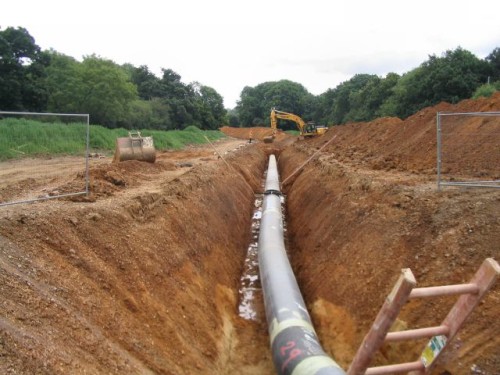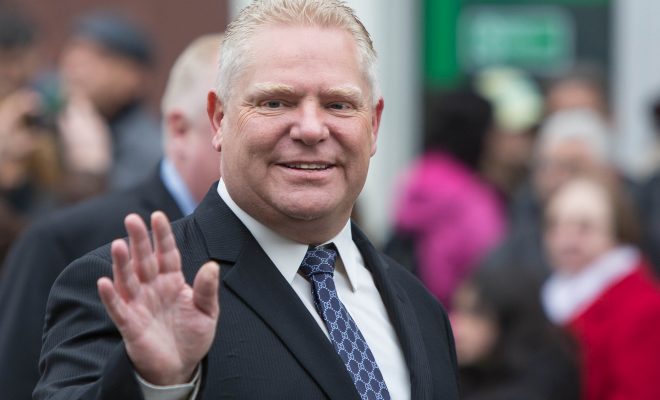The Doug Ford government in Ontario faced widespread ridicule last week for an inept anti-carbon tax video that delivered the opposite of its intended message when played on mute.
The TV ad showed nickels cascading out of air vents, fuel pumps, and store shelves, in a bid to illustrate the surcharges Ontarians could expect to pay as a result of the federal backstop price on carbon.
Provincial Auditor General Bonnie Lysyk had already criticized the ad campaign for failing to reflect all the “relevant facts”—including federal rebates that will work out to the advantage of most of the province’s households. But the outright mockery began when Smart Prosperity Senior Director Mike Moffatt spotted and tweeted about a small problem with the ads.
“Did nobody in the government watch this with the sound off?” he tweeted. “This literally looks like an ad *promoting* the carbon rebate. You’ll be showered with money!”
“You’ll have so much money, it’ll pour out of your vents,” he added. “Every time you open your wallet, money will fall out, because you’ll have so much of it.”
Moffatt’s Twitter followers got into the act, and hilarity ensued.
“Good thing nobody mutes their TV during commercial breaks, eh?” said Scott Piatkowski.
“I always watch videos on social silently,” said Mark Chapeskie, and “this absolutely looks like money coming from everywhere! Quick grab some buckets!”
“This is actually hilarious!!” agreed Leah Miltchin. “The obvious symbolism would have been, oh, I don’t know, say a vacuum cleaner sucking money out of people’s wallets. How much did the PCs pay the ad agency that came up with this?”
“Did they upload this to Twitter in reverse?” asked Kevin Milligan. “Does it say ‘Paul is dead’?”
“I filled up today and not one nickel dropped,” tweeted one disappointed viewer. “I brought a bucket to the grocers to catch the money waterfall, but alas, nothing. Maybe file complaints to the [Canadian Radio-Television and Telecommunications Commission] for this misleading advert.”
Then Braeson Holland, press secretary to federal International Development Minister Maryam Monsef, decided the ad could do with a new voiceover. “Fixed a few things in [Premier Doug Ford]’s climate change attack ad,” he tweeted.
“The federal government has put a price on pollution,” the new narrator intoned over the original footage. “They made it revenue neutral, so big polluters are paying and you get a rebate.”
“It works great,” Wilfrid Laurier University associate professor of digital communications Simon Kiss said of the spoof. “The script in the parody is honestly more logical and fits the visuals better than the government’s own ad.”
But despite a badly-needed moment of catharsis, critics warn that such propaganda is far from harmless—reflecting the Ford government’s preference to rule by sensationalism and stealth, rather than governing through sober reflection and consultation. A case in point was its recent decision to cut funding to a non-profit dedicated to ensuring Indigenous involvement in conservation and natural resource management by 70%— without notice or consultation.
The Anishinabek/Ontario Fisheries Resource Centre (A/OFRC) first learned its mandate was in peril the day after the provincial budget was read, via a letter from the Ontario Ministry of Natural Resources informing the organization that it was “seeking changes” to its current funding package, National Observer reports.
Prior to the Ministry letter, the centre understood itself to be at the beginning of the second year in a three-year transfer payment agreement, providing an annual budget of $860,000. “The money was part of a critical program designed to help about 40 First Nations participate in government decision-making related to conservation policies.”
Two days after being warned of coming “changes” to its budget, “the Anishinabek/Ontario Fisheries Resource Centre was informed by the ministry that their transfer payment had been reduced by 70%, to $250,000, for the 2019/20 year.” There is as yet no provincial commitment to funding for next year, Observer adds.
All of this came as a terrible shock to the organization. “We had no indication, prior to the receipt of the letter on April 12, that we were specifically targeted for funding cuts. We had certainly no indication that we were looking at cuts of the magnitude of 70% of our baseline that we ended up being handed,” said A/OFRC General Manager Peter Meisenheimer.
“We’re scrambling right now, having already begun our fiscal year and project season, to find alternative sources of money, and we’re making a very serious effort to make sure the important work of our organization goes on and that we can do what we’ve done for the last quarter of century,” he added.
Formed in 1993 “to mend contentious relationships between the Anishinabek First Nation and the then Conservative government led by Premier Mike Harris,” the centre has proven its worth, said former Ontario Regional Chief Isadore Day. Having developed both technical and reporting capacity, as well as a storehouse of knowledge both Indigenous and science-based, A/OFRC has become “something of an important institution” in its ability to nurture productive relations between the province and First Nations.
“The centre began its field season last month and had a list of 15 to 20 projects scheduled or under way, including one looking at the health of fish in the Thames River with the Chippewa First Nation,” Observer reports. Now, with “only enough money left to pay for one staff member and a small office,” its future is uncertain.
A spokesperson for Ontario Natural Resources Minister John Yakabuski said the province’s 2019 budget was the product of a “close and thorough review” that was “meant to ensure that duplication is eliminated, and valuable programs and services are delivering outcomes for the people of Ontario.”
Describing the cuts as “callous” and shortsighted, Day said the sudden change to centre operations will mean the loss of precious data that would otherwise help Ontario fight climate change.Recent polls show support for the Ford government falling fast under the weight of brutal budget cuts, with the Pollara Strategic Insights survey placing its popular support at 30%, down from 40.5% less than a year ago. An Environics Research survey foundthat 75% of Ontarians think the province is on the wrong track.





